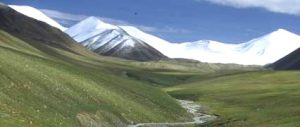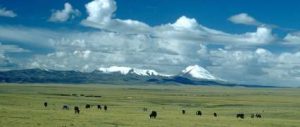Published reports about the likely consequences of climate change across the Greater Himalayas (including the Qinghai-Tibetan Plateau) reveal broad agreement that warming in the region will lead to long-term:
• Loss of glacial ice with a corresponding reduction in water availability;
• Increasing incidents of natural disasters such as flooding and glacial lake outburst floods;
• Greater environmental and social risks to both upstream and downstream human communities.
Studies of climate change across the Greater Himalayas portray a very uncertain future, yet governments of countries in the region have been slow to begin planning for climate adaptations. There are still many information gaps, and data that do exist are complex and often difficult to interpret. Integrated ecological, hydrological and social studies have yet to be completed. The problem is that people must act now in order to reduce future negative consequences.
In order to help citizens, community leaders, politicians and policymakers understand better projected climate–change impacts in the Greater Himalayas, we performed a comprehensive review of current studies with an eye toward cascading effects on water, biodiversity and human livelihoods. Cascading effects are those unanticipated events that result as ecosystems respond to change. When these effects are accounted for, a more nuanced and problematic picture of regional climate impacts emerges.
The Greater Himalaya region, also known as “Asia’s water tower”, covers some seven million square kilometres and has a highly heterogeneous geography: from subtropical semi-desert and low tropical evergreen forests, to alpine ecosystems below the highest peaks in the world. The Himalayan massif affects regional weather; the mountains form a physical barrier to atmospheric circulation for the summer monsoons and winter westerlies. Species and ecosystem diversity is high; of the world’s 34 biodiversity hotspots, four are found here. Beyond biodiversity, the Greater Himalayas form the headwaters of 10 of the largest rivers in Asia, whose basins provide water for about 1.3 billion people.
Climate-change impacts are already occurring in the Greater Himalayas, most notably the widely reported reduction of glacial ice [pdf]. Regional temperatures are increasing at about three times the global average. United Nations Intergovernmental Panel on Climate Change (IPCC) 2007 data, now considered by many to be too conservative, project further warming of 3° Celsius by 2050 and about 5° Celsius in the 2080s over the Asian land mass. Warming will be even greater on the Qinghai-Tibetan Plateau. Though glacial loss may be mitigated somewhat by projected increases in precipitation, the best current projections show that ice may disappear from the Greater Himalayas by mid-century or before.
Water is a critical resource for ecosystems and people; there will be multiple cascading effects from the reduction of Greater Himalayas ice and snow. Processes determining the conversion of frozen water into downstream flow are complex, but based on current knowledge the rivers most likely to experience the greatest reduction in water availability are the Indus, Yangtze, Tarim, Brahmaputra and Amu Daryu. The Indus, for example, gets 44.8% of its stream flow from melt water. The Yangtze receives somewhat less than 20%. Reductions in these flows should trigger concern: the number of people living in these two basins is 178 million and 368 million, respectively.
Species are already responding to climate change in the Greater Himalayas. Rhododendrons are flowering up to a month earlier than historical averages. For other plants, rising temperatures are altering the timing of flowering and leaf flush and these changes will cause cascading effects in the behaviors of pollinators and other flower-dependent animals. Historical plagues of the high elevation Tibetan migratory locust, for example, are closely related to droughts. Spider predation on grasshoppers decreases with rising temperatures. In general, the overwintering eggs of insect pests are likely to have higher survival rates with warmer winters, which will lead to more herbivory on crop plants. Weedy, exotic species from lower elevations will likely invade into higher areas. Less water and disruptions of the normal timing of ecological events will have uncertain consequences for many species; some species will decrease, some will increase. The potential for species extinctions due to climate change has been reported widely, but the consequences of complex cascading effects are underappreciated by most people.
Ecosystem dynamics are expected to change, too. It is highly likely that the composition and distribution of vegetation types throughout the Greater Himalayas are very likely to shift significantly. Water timing and availability influence where high-altitude meadows, steppes, grasslands and deserts are distributed. Today on the Qinghai-Tibetan Plateau, alpine steppe and deserts cover 33.5% of the region; these ecosystems are expected to contract in area by about 16%. Forests on the Plateau are projected to increase in area. Since 1923, tree lines have shifted upward by 67 metres in northwest Yunnan province, while over the last decade in the western Himalayas, upward shifts have averaged about 16 metres. It remains unclear what such wholesale shifts in plant communities will mean for ecosystem functioning over time.
Water availability, species interactions, ecosystem shifts and stability are linked by multiple ecological feedbacks, but basic research exploring these interconnections is notably lacking in the Greater Himalayas. To complete our review, we focused on two broad categories of cascading effects: ecosystems and livelihoods impacts; and downstream and global consequences.
One primary concern we have with impacts on ecosystems and livelihoods is the unprecedented speed and scale of projected climatic changes. Many of the endemic species that live in the Greater Himalayas may not be able to adapt to such rapid transformation of the environmental conditions that they have evolved in. This same logic applies to humans. For people, effective climate adaptations include the capacity to gather and interpret new information, the creation of responsive governance, as well as actual changes in livelihood practices to meet changing conditions. Climate change is not new for Himalayan people. Mountain dwellers across many cultures, for example, have used riverbank retaining walls and terraces to mitigate flooding, as well as regional migration to avoid the worst environmental hazards. But there are virtually no studies that examine existing adaptive capacities and potential vulnerabilities of local communities across the Greater Himalayas.
Quantitative projections of potential downstream and global cascading effects due to climate change are also rare. We are especially concerned about cascading effects influencing downstream water availability, atmospheric circulation, sea level rise and loss of Qinghai-Tibetan Plateau permafrost.
Some 22% of all people on earth are sustained by Asia’s water tower, but there are no full-scale studies of how climate change may reduce downstream flows. Reduced downstream flows mean reduced food production in a region where there are already 523 million undernourished people and population growth rates are some of the highest in the world.
While regional food production is critical to the well-being of many people, the Greater Himalayas also play a key role in global atmospheric circulation. In summer, the vast highlands heat up more than the Indian Ocean, leading to a pressure gradient that drives the Indian monsoon. There is some evidence, however, that this gradient may be changing due to the reduction of ice and snow in the Greater Himalayas.
Loss of regional ice and snow will have still-unknown cascading effects on global sea-level rise. Recent research projections have doubled the worldwide minimum average rise to 80 centimetres by 2100, which would have severe effects on human populations and agricultural lands in the coastal mega deltas of Asia, where Greater Himalayan rivers meet the sea.
The Greater Himalayas are also an important carbon sink. Frozen soils subtending Qinghai-Tibetan Plateau grasslands store some 2.5% of global soil carbon, but projected warming and the resulting shift in ecosystems could lead to the near-complete disappearance of permafrost, with the cascading effect of releasing most of the region’s soil carbon. No model exists yet that captures the interactions of these critical variables: melting glaciers and snow; degraded permafrost and wetlands; shifting alpine ecosystems; and potential changes in monsoon moisture patterns.
Current trends portray great environmental uncertainty in the Greater Himalayas. Given the general lack of data and levels of scientific uncertainty, we recommend: more widespread and long-term tracking of glacial ice volumes; monitoring of high-altitude flora and fauna; open sharing of data; and greater cooperation between all countries in the Greater Himalayas. At the local level, we believe upstream rural people should be brought into natural resource decision-making. Policies addressing downstream populations, urban infrastructure, and large-scale agricultural systems must be integrated with mountain peoples’ livelihoods issues and concerns. River basin research should emphasize reducing overall water demand and modernising irrigated agriculture with maximal efficiency in mind.
Across all countries in the Greater Himalayas, risk assessment and mapping would help decision-makers select appropriate strategies. But we found no regional or transboundary authority addressing the complexities of climate-induced cascading effects outlined here. This situation must change. China and India play critical roles because most of the Greater Himalayas are within the borders of these two nations. We would like to see these two countries exert more leadership. As much as we would welcome the formation of a regional Greater Himalayan climate-change authority, we recognise that top-down policymaking has a mixed track record in the region. But current evidence and the potential for severely negative cascading effects show that the status quo can no longer hold; political leaders must act.
Dr R Edward Grumbine teaches in the Environmental Studies Program at Prescott College, Arizona, United States. His interests include biodiversity protection and conservation practices in China. Dr Xu Jianchu works at the Key Laboratory of Biodiversity and Biogeography, Kunming Institute of Botany and the World Agroforestry Centre, China Program, Kunming, China. He focuses on river basin biodiversity and local livelihoods throughout the Greater Himalaya.
The authors would like to thank their colleagues A. Shrestha, M. Eriksson, X. Yang, Y. Wang, and A. Wilkes who contributed to the original paper, as well as Blackwell Scientific and Conservation Biology for permission to publish an adapted version of the article titled “The Melting Himalayas: Cascading Effects of Climate Change on Water, Biodiversity, and Human Livelihoods” Conservation Biology, 23:3, 2009:520-530.
Homepage photo by DexterPerrin



